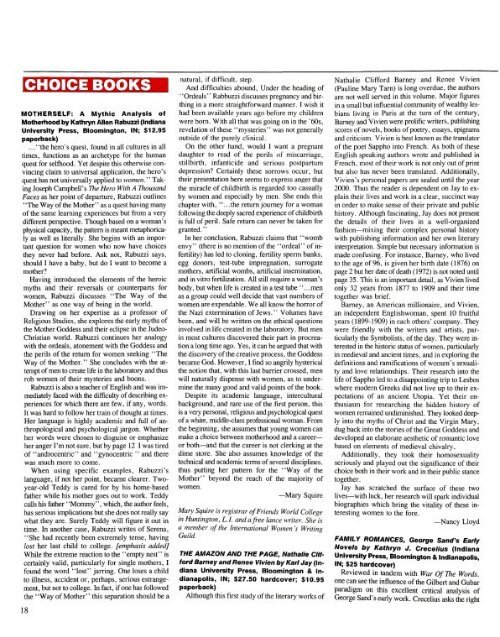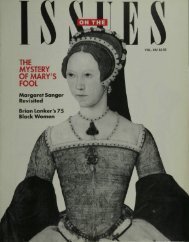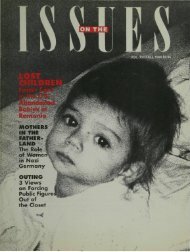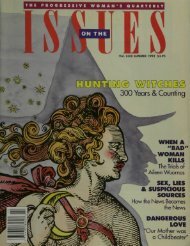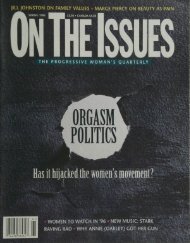view entire issue in pdf format - On The Issues Magazine
view entire issue in pdf format - On The Issues Magazine
view entire issue in pdf format - On The Issues Magazine
Create successful ePaper yourself
Turn your PDF publications into a flip-book with our unique Google optimized e-Paper software.
MOTHERSELF: A Mythic Analysis of<br />
Motherhood by Kathryn Allen Rabuzzi (Indiana<br />
University Press, Bloom<strong>in</strong>gton, IN; $12.95<br />
paperback)<br />
..."the hero's quest, found <strong>in</strong> all cultures <strong>in</strong> all<br />
times, functions as an archetype for the human<br />
quest for selfhood. Yet despite this otherwise conv<strong>in</strong>c<strong>in</strong>g<br />
claim to universal application, the hero's<br />
quest has not universally applied to women.'' Tak<strong>in</strong>g<br />
Joseph Campbell's <strong>The</strong> Hero With A Tliousand<br />
Faces as her po<strong>in</strong>t of departure, Rabuzzi outl<strong>in</strong>es<br />
"<strong>The</strong> Way of the Mother" as a quest hav<strong>in</strong>g many<br />
of the same learn<strong>in</strong>g experiences but from a very<br />
different perspective. Though based on a woman's<br />
physical capacity, the pattern is meant metaphoricaly<br />
as well as literally. She beg<strong>in</strong>s with an important<br />
question for women who now have choices<br />
they never had before. Ask not, Rabuzzi says,<br />
should I have a baby, but do I want to become a<br />
mother?<br />
Hav<strong>in</strong>g <strong>in</strong>troduced the elements of the heroic<br />
myths and their reversals or counterparts for<br />
women, Rabuzzi discusses "<strong>The</strong> Way of the<br />
Mother" as one way of be<strong>in</strong>g <strong>in</strong> the world.<br />
Draw<strong>in</strong>g on her expertise as a professor of<br />
Religious Studies, she explores the early myths of<br />
the Mother Goddess and their eclipse <strong>in</strong> the Judeo-<br />
Christian world. Rabuzzi cont<strong>in</strong>ues her analogy<br />
with the ordeals, atonement with the Goddess and<br />
the perils of the return for women seek<strong>in</strong>g "<strong>The</strong><br />
Way of the Mother." She concludes with the attempt<br />
of men to create life <strong>in</strong> the laboratory and thus<br />
rob women of their mysteries and boons.<br />
Rabuzzi is also a teacher of English and was immediately<br />
faced with the difficulty of describ<strong>in</strong>g experiences<br />
for which there are few, if any, words.<br />
It was hard to follow her tra<strong>in</strong> of thought at times.<br />
Her language is highly academic and full of anthropological<br />
and psychological jargon. Whether<br />
her words were chosen to disguise or emphasize<br />
her anger I'm not sure, but by page 12 I was tired<br />
of "androcentric" and "gynocentric " and there<br />
was much more to come.<br />
When us<strong>in</strong>g specific examples, Rabuzzi's<br />
language, if not her po<strong>in</strong>t, became clearer. Twoyear-old<br />
Teddy is cared for by his home-based<br />
father while his mother goes out to work. Teddy<br />
calls his father "Mommy", which, the author feels,<br />
has serious implications but she does not really say<br />
what they are. Surely Teddy will figure it out <strong>in</strong><br />
time. In another case, Rabuzzi writes of Serena,<br />
"She had recently been extremely tense, hav<strong>in</strong>g<br />
lost her last child to college, [emphasis added]<br />
While the extreme reaction to the "empty nest" is<br />
certa<strong>in</strong>ly valid, particularly for s<strong>in</strong>gle mothers, I<br />
found the word "lost" jarr<strong>in</strong>g. <strong>On</strong>e loses a child<br />
to illness, accident or, perhaps, serious estrangement,<br />
but not to college. In fact, if one has followed<br />
the "Way of Mother" this separation should be a<br />
18<br />
natural, if difficult, step.<br />
And difficulties abound, Under the head<strong>in</strong>g of<br />
"Ordeals" Rabbuzzi discusses pregnancy and birth<strong>in</strong>g<br />
<strong>in</strong> a more straightforward manner. I wish it<br />
had been available years ago before my children<br />
were born. With all that was go<strong>in</strong>g on <strong>in</strong> the '60s,<br />
revelation of these "mysteries" was not generally<br />
outside of the purely cl<strong>in</strong>ical.<br />
<strong>On</strong> the other hand, would I want a pregnant<br />
daughter to read of the perils of miscarriage,<br />
stillbirth, <strong>in</strong>fanticide and serious postpartum<br />
depression? Certa<strong>in</strong>ly these sorrows occur, but<br />
their presentation here seems to express anger that<br />
the miracle of childbirth is regarded too casually<br />
by women and especially by men. She ends this<br />
chapter with, "...the return journey for a woman<br />
follow<strong>in</strong>g the deeply sacred experience of childbirth<br />
is full of peril. Safe return can never be taken for<br />
granted."<br />
In her conclusion, Rabuzzi claims that "womb<br />
envy" (there is no mention of the "ordeal" of <strong>in</strong>fertility)<br />
has led to clon<strong>in</strong>g, fertility sperm banks,<br />
egg donors, test-tube impregnation, surrogate<br />
mothers, artificial wombs, artificial <strong>in</strong>sem<strong>in</strong>ation,<br />
and <strong>in</strong> vitro fertilization. All still require a woman's<br />
body, but when life is created <strong>in</strong> a test tube "...men<br />
as a group could well decide that vast numbers of<br />
women are expendable. We all know the horror of<br />
the Nazi exterm<strong>in</strong>ation of Jews." Volumes have<br />
been, and will be written on the ethical questions<br />
<strong>in</strong>volved <strong>in</strong> life created <strong>in</strong> the laboratory. But men<br />
<strong>in</strong> most cultures discovered their part <strong>in</strong> procreation<br />
a long time ago. Yes, it can be argued that with<br />
the discovery of the creative process, the Goddess<br />
became God. However, I f<strong>in</strong>d so angrily hysterical<br />
the notion that, with this last barrier crossed, men<br />
will naturally dispense with women, as to underm<strong>in</strong>e<br />
the many good and valid po<strong>in</strong>ts of the book.<br />
Despite its academic language, <strong>in</strong>tercultural<br />
background, and rare use of the first person, this<br />
is a very personal, religious and psychological quest<br />
of a white, middle-class professional woman. From<br />
the beg<strong>in</strong>n<strong>in</strong>g, she assumes that young women can<br />
make a choice between motherhood and a career—<br />
or both—and that the career is not clerk<strong>in</strong>g at the<br />
dime store. She also assumes knowledge of the<br />
technical and academic terms of several discipl<strong>in</strong>es,<br />
thus putt<strong>in</strong>g her pattern for the "Way of the<br />
Mother" beyond the reach of the majority of<br />
women.<br />
—Mary Squire<br />
Mary Squire is registrar of Friends World College<br />
<strong>in</strong> Hunt<strong>in</strong>gton, LI. and a free lance writer. She is<br />
a member of the International Women's Writ<strong>in</strong>g<br />
Guild.<br />
THE AMAZON AND THE PAGE, Nathalie Clifford<br />
Barney and Renee Vivien by Karl Jay (Indiana<br />
University Press, Bloom<strong>in</strong>gton & Indianapolis,<br />
IN; $27.50 hardcover; $10.95<br />
paperback)<br />
Although this firststudy of the literary works of<br />
Nathalie Clifford Barney and Renee Vivien<br />
(Paul<strong>in</strong>e Mary Tarn) is long overdue, the authors<br />
are not well served <strong>in</strong> this volume. Major figures<br />
<strong>in</strong> a small but <strong>in</strong>fluential community of wealthy lesbians<br />
liv<strong>in</strong>g <strong>in</strong> Paris at the turn of the century,<br />
Barney and Vivien were prolific writers, publish<strong>in</strong>g<br />
scores of novels, books of poetry, essays, epigrams<br />
and criticism. Vivien is best known as the translator<br />
of the poet Sappho <strong>in</strong>to French. As both of these<br />
English speak<strong>in</strong>g authors wrote and published <strong>in</strong><br />
French, most of their work is not only out of pr<strong>in</strong>t<br />
but also has never been translated. Additionally,<br />
Vivien's personal papers are sealed until the year<br />
2000. Thus the reader is dependent on Jay to expla<strong>in</strong><br />
their lives and work <strong>in</strong> a clear, succ<strong>in</strong>ct way<br />
<strong>in</strong> order to make sense of their private and public<br />
history. Although fasc<strong>in</strong>at<strong>in</strong>g, Jay does not present<br />
the details of their lives <strong>in</strong> a well-organized<br />
fashion—mix<strong>in</strong>g their complex personal history<br />
with publish<strong>in</strong>g <strong>in</strong><strong>format</strong>ion and her own literary<br />
<strong>in</strong>terpretation. Simple but necessary <strong>in</strong><strong>format</strong>ion is<br />
made confus<strong>in</strong>g. For <strong>in</strong>stance, Barney, who lived<br />
to the age of 96, is given her birth date (1876) on<br />
page 2 but her date of death (1972) is not noted until<br />
page 35. This is an important detail, as Vivien lived<br />
only 32 years from 1877 to 1909 and their time<br />
together was brief.<br />
Barney, an American millionaire, and Vivien,<br />
an <strong>in</strong>dependent Englishwoman, spent 10 fruitful<br />
years (1899-1909) <strong>in</strong> each others' company. <strong>The</strong>y<br />
were friendly with the writers and artists, particularly<br />
the Symbolists, of the day. <strong>The</strong>y were <strong>in</strong>terested<br />
<strong>in</strong> the historic status of women, particularly<br />
<strong>in</strong> medieval and ancient times, and <strong>in</strong> explor<strong>in</strong>g the<br />
def<strong>in</strong>itions and ramifications of women's sexuality<br />
and love relationships. <strong>The</strong>ir research <strong>in</strong>to the<br />
life of Sappho led to a disappo<strong>in</strong>t<strong>in</strong>g trip to Lesbos<br />
where modern Greeks did not live up to their expectations<br />
of an ancient Utopia. Yet their enthusiasm<br />
for research<strong>in</strong>g the hidden history of<br />
women rema<strong>in</strong>ed undim<strong>in</strong>ished. <strong>The</strong>y looked deeply<br />
<strong>in</strong>to the myths of Christ and the Virg<strong>in</strong> Mary,<br />
dug back <strong>in</strong>to the stories of the Great Goddess and<br />
developed an elaborate aesthetic of romantic love<br />
based on elements of medieval chivalry.<br />
Additionally, they took their homosexuality<br />
seriously and played out the significance of their<br />
choice both <strong>in</strong> their work and <strong>in</strong> their public stance<br />
together.<br />
Jay has scratched the surface of these two<br />
lives—with luck, her research will spark <strong>in</strong>dividual<br />
biographies which br<strong>in</strong>g the vitality of these <strong>in</strong>terest<strong>in</strong>g<br />
women to the fore.<br />
—Nancy Lloyd<br />
FAMILY ROMANCES, George Sand's Early<br />
Novels by Kathryn J. Crecelius (Indiana<br />
University Press, Bloom<strong>in</strong>gton & Indianapolis,<br />
IN; $25 hardcover)<br />
Re<strong>view</strong>ed <strong>in</strong> tandem with War Of <strong>The</strong> Words,<br />
one can see the <strong>in</strong>fluence of the Gilbert and Gubar<br />
paradigm on this excellent critical analysis of<br />
George Sand's early work. Crecelius asks the right


